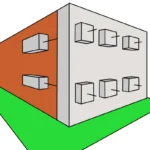What is a Pavement?
provide a walkable and resilient surface. Its primary purpose is to support traffic loads, protect the underlying ground, and provide a safe and comfortable surface for vehicles and pedestrians.
Components of a Pavement
A typical pavement consists of several layers:

1. Subbase:
While the subbase layer may seem less imposing in terms of robust materials, it plays an equally critical role in the integrity of a pavement. Its primary function is to evenly distribute the loads generated by traffic and safeguard the underlying ground against deformations. It has multiple essential functions:
Structural Support: The subbase plays a critical role in providing solid structural support to the pavement. Its primary function is to evenly distribute the loads generated by vehicular traffic. This aspect is crucial in preventing deformations and settlements that could damage the pavement’s integrity.
Drainage: Another crucial aspect is its ability to manage pavement drainage efficiently, preventing the accumulation of water beneath the pavement. This is essential to preserve the integrity of the pavement structure and extend its lifespan since water accumulation could cause damage and erosion.
Soil Property Enhancement: In certain situations, the subbase can be used to enhance the properties of the underlying soil. This is especially useful when the natural ground lacks the necessary strength. The subbase can be enriched by incorporating stabilizing materials, thus improving the load-bearing capacity and soil resistance.
Increased Structural Strength: Finally, the subbase significantly contributes to the overall load-bearing capacity of the pavement, allowing it to withstand heavier loads without damage.
To effectively perform these functions, the subbase must meet certain requirements:
Materials: The materials used in the subbase can vary depending on the specific project’s needs and conditions. Common materials include gravel, crushed stone, sand, and chemically stabilized or geotextile-reinforced soils.
Thickness: The subbase thickness varies depending on factors such as the required load-bearing capacity, the type of traffic, and the characteristics of the underlying ground.
Compaction: Proper compaction is essential to ensure the stability and strength of the subbase. Compaction equipment, such as vibratory rollers, is used to achieve optimal material density.
Stabilization: In certain circumstances, chemical stabilization or geotextiles may be used to improve the quality of the subbase, especially in areas subject to heavy traffic or on natural soils with low load-bearing capacity.
Moisture Control: During subbase construction, it is crucial to maintain proper moisture control, as excessive water can weaken the layer. Moisture control techniques, such as controlled water addition or drainage systems, are implemented according to the specific project’s needs.
2. Base:
The base layer is one of the fundamental layers that make up a pavement and is directly below the pavement’s wearing surface (whether it’s asphalt or concrete). This layer is essential for the pavement’s performance and has several important functions:
Load Support: The primary function of the base is to provide solid structural support for the pavement. It evenly and efficiently distributes traffic loads to the subbase and underlying ground. Without a proper base, the pavement could deform and deteriorate quickly.
Distribution of Stresses: The base acts as a cushion, evenly distributing traffic loads across the road surface. This helps prevent pavement cracking and deformation, thereby improving durability.
Moisture Resistance: The base also plays a role in water control. It helps prevent moisture from penetrating from the subbase upwards, which could weaken the pavement. Good drainage and resistance to water infiltration are essential features of an effective base.
Load-Bearing Capacity Enhancement: In some cases, especially in areas with heavy traffic or poor underlying soils, enhanced base materials may be used. These materials can include chemical stabilizers or geotextiles to increase the base’s load-bearing capacity.
Base Materials:
The materials used in base construction vary depending on the location and project requirements. Common materials include:
Aggregates: Gravel and crushed stone are common choices. These materials must meet certain quality standards to ensure base strength and durability.
Stabilized Soil: In some cases, natural soil can be stabilized by adding chemicals or geotextiles. This improves its properties and load-bearing capacity.
Base Layer Thickness:
The thickness of the base layer can vary depending on factors such as the type of traffic, required load-bearing capacity, and ground conditions. In projects with heavy traffic, it’s common for the base to be thicker to provide the necessary support.
Compaction and Quality Control:
The base must be carefully compacted during construction to ensure its stability and strength. Compaction equipment, such as vibratory rollers, is used to achieve the required material density. Additionally, quality tests are conducted to verify that the base meets the necessary standards.
3. Wearing Surface:
The wearing surface, also known as the pavement surface, is the top layer of the pavement that directly interacts with vehicles and pedestrians, serving several essential functions:
Wear Resistance: One of its primary functions is to withstand the wear and tear caused by constant vehicle traffic. It must be durable and able to resist abrasion from tires and erosion caused by weather conditions.
Traction and Road Safety: The wearing surface must provide adequate traction to prevent vehicle slippage, especially in rainy or snowy conditions. Slippery pavements can be dangerous, so the texture and composition of the surface are critical for road safety.
Driver Comfort: A well-designed wearing surface contributes to driver and passenger comfort. It should be smooth enough for a comfortable ride while preventing puddle formation and water stagnation, which could lead to hydroplaning.
Noise Reduction: In urban and residential areas, special wearing surfaces can be used to reduce traffic noise. These surfaces absorb sound and help minimize noise pollution.
Wearing Surface Materials:The materials used on the wearing surface vary depending on the project’s specific needs and conditions:
Asphalt Pavements: In asphalt pavements, the wearing surface is primarily composed of an asphalt mixture. This mixture includes asphalt (binder), mineral aggregates (such as gravel and sand), and possibly additives to enhance strength and adhesion.
Concrete Pavements: In concrete pavements, the wearing surface consists of concrete slabs. Concrete is highly resistant to wear and abrasion, making it suitable for areas with heavy traffic.
Maintenance and Renewal: The wearing surface undergoes constant wear due to traffic and weather conditions. Therefore, regular maintenance is essential to preserve its quality. This may include minor repairs, crack sealing, resurfacing, and milling to remove irregularities.
Innovations in Wearing Surfaces:
Road engineering continues to develop new technologies and materials to improve the quality and performance of wearing surfaces. This includes the use of special aggregates, modified asphalt, and permeable pavements, among other innovations.
The wearing surface is the most visible and critical part of a pavement and plays an essential role in road safety and performance. Proper design, composition, and maintenance are fundamental to ensuring safe and durable road infrastructure.
Difference Between Base and Subbase
specific functions to ensure strength, durability, and proper load distribution. Both are fundamental layers but serve different roles in load distribution and pavement support:
The base is closer to the wearing surface and is the layer that directly supports vehicular and pedestrian traffic, while the subbase is located beneath the base and primarily distributes loads to the underlying ground.
Base materials are stronger and have a higher load-bearing capacity compared to subbase materials, which are less resilient but still essential for pavement performance.
The base is crucial for structural strength and pavement durability, while the subbase focuses on preventing ground deformations.
Types of Pavements
Pavements can be classified into two main categories:
Flexible Pavements: Composed of asphalt layers, they are more flexible and adaptable to ground deformations. They are commonly used on roads and urban streets.
Rigid Pavements: Made of concrete, they are sturdier, making them ideal for areas with heavy traffic, such as highways and airports.
Importance of Pavements
Pavements play a crucial role in our society. Here are some reasons why they are so important:
Facilitating Mobility: Pavements enable efficient movement of vehicles and pedestrians. Without paved roads, streets, and sidewalks, mobility would be extremely difficult and slow. This is essential for the economy and community connectivity, as it facilitates the transportation of goods and services.
Road Safety: Well-maintained pavements greatly contribute to road safety. They provide a smooth and even surface that reduces the risk of accidents and minimizes damage in case of collisions. Road markings and signs are placed on pavements to guide drivers and pedestrians safely.
Cost Reduction: Proper pavement maintenance is essential for long-term cost reduction. Without preventive maintenance, pavements can deteriorate rapidly, leading to costly repairs. Adequate maintenance extends the lifespan of pavements and avoids excessive expenses.
Transport Efficiency: Quality pavements enhance transportation efficiency by reducing travel time and fuel consumption. This has a direct impact on the economy by reducing fuel costs and optimizing the logistics of goods transportation.
Quality of Life: The presence of pavements influences people’s quality of life. They provide access to essential services such as hospitals, schools, and workplaces. Additionally, they offer recreational areas for outdoor activities and sports, promoting an active and healthy lifestyle.
Economic Development: Pavements are a fundamental part of infrastructure that attracts investments and promotes economic development. Communities well-connected by pavement networks attract businesses and tourism, creating jobs and increasing local income.
Environmental Impact: Good pavement design can have a positive impact on the environment. Permeable pavements, for example, allow rainwater to infiltrate the soil, reducing runoff and preventing erosion and water pollution.







Related
Flexible Pavement vs. Rigid Pavement: What’s the Difference?
What is Rigid Pavement?
What is Flexible Pavement?